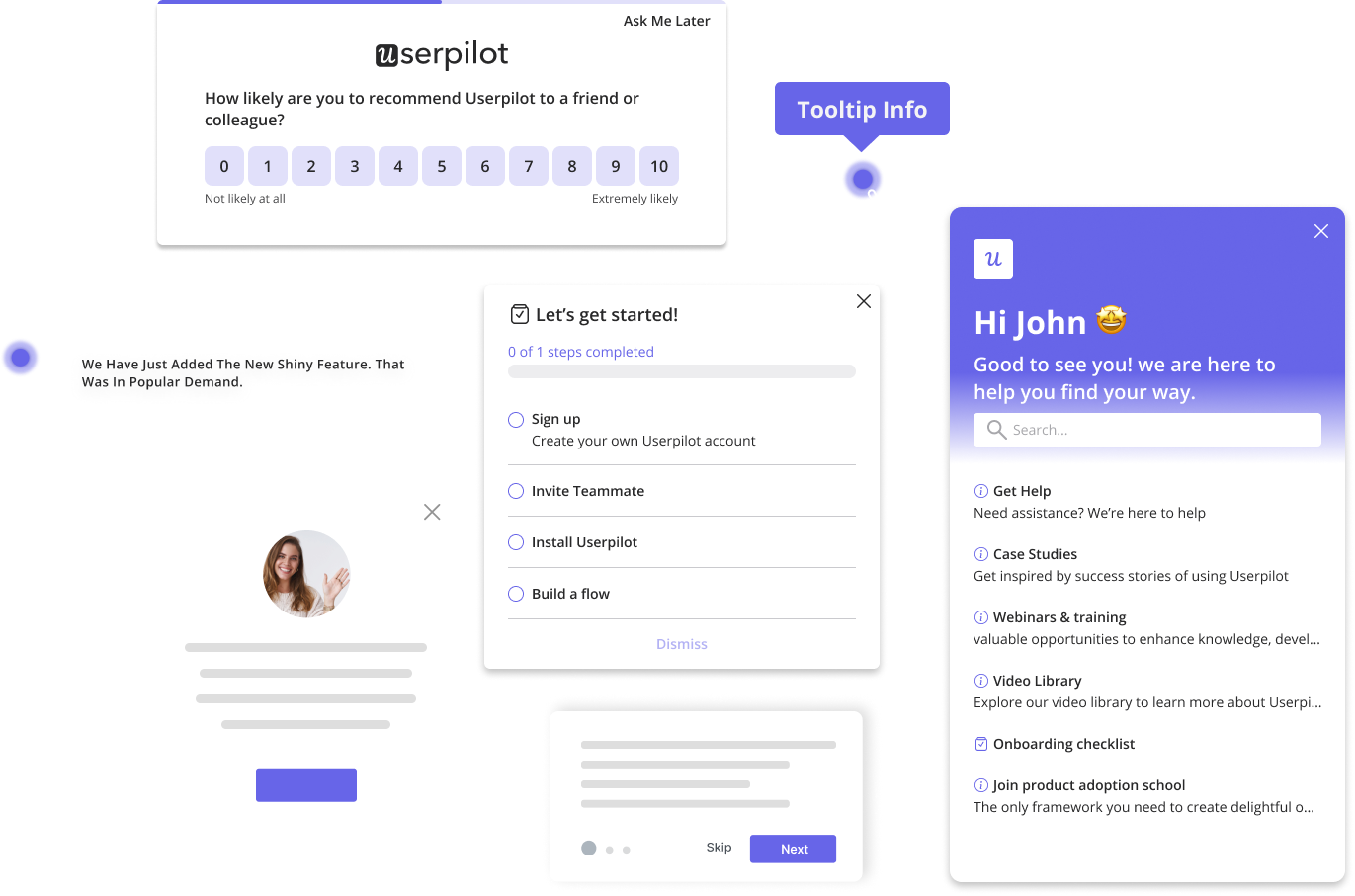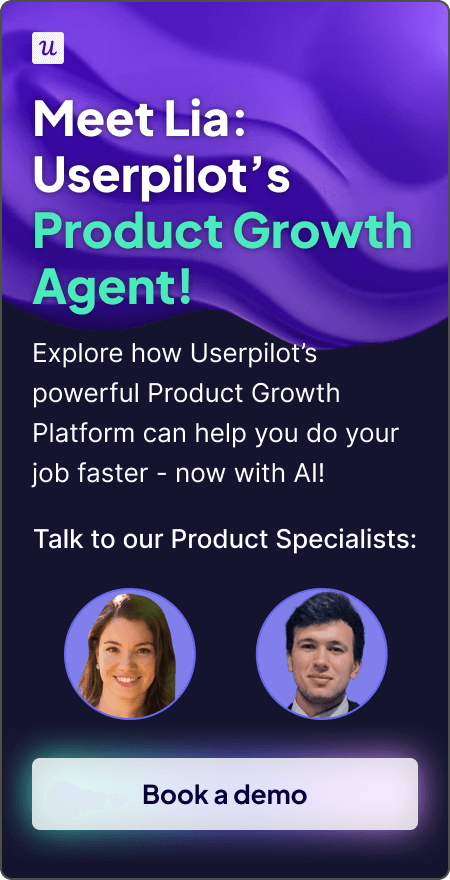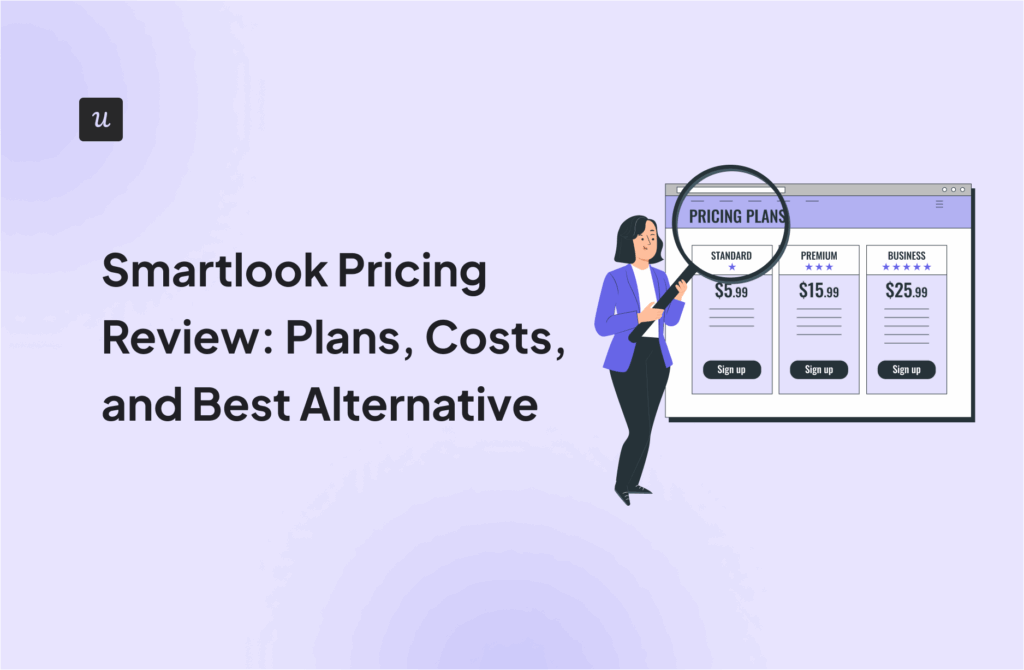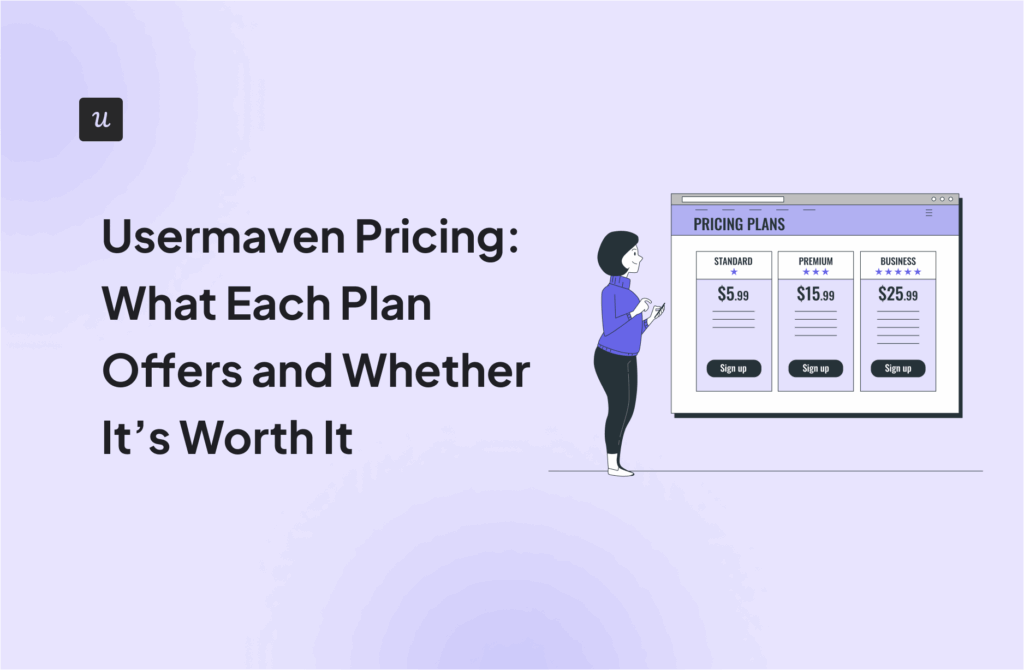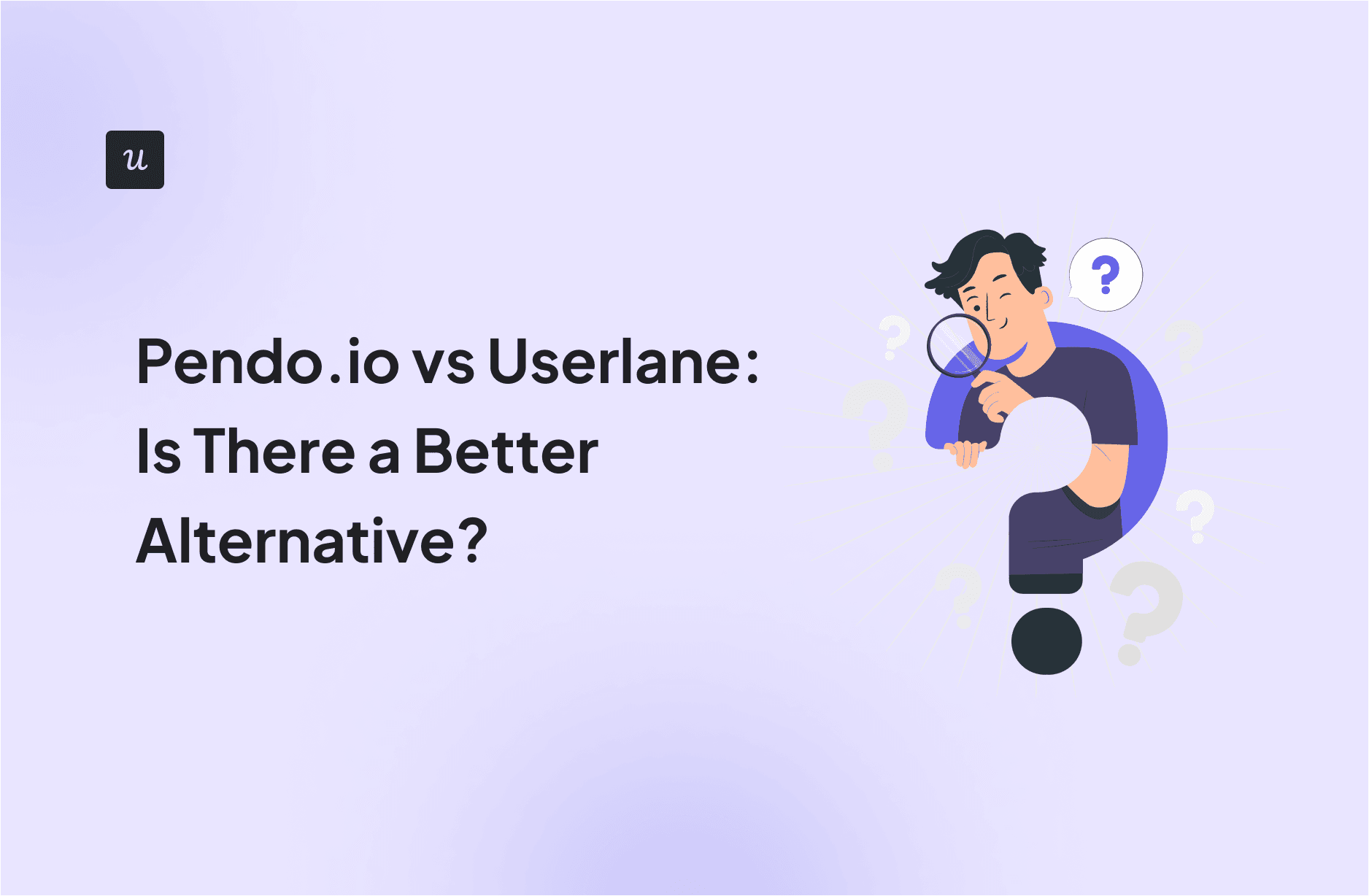
This Pendo vs Userlane guide is my take as a product manager on which platform fits your roadmap, team, and users.
I’ll compare Pendo and Userlane’s major features, including user engagement, product analytics, implementation speed, integration capabilities, and even pricing. Then, show you where Userpilot is a better alternative.
By the end, you’ll know which tool is best for supporting your product adoption and growth goals.
Try Userpilot Now
See Why 1,000+ Teams Choose Userpilot
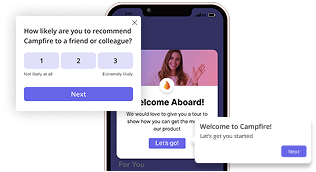
Pendo.io Overview
Pendo is a software experience management (SXM) platform that combines product analytics, in-app guides, feedback, session replay, and roadmapping into a single stack.
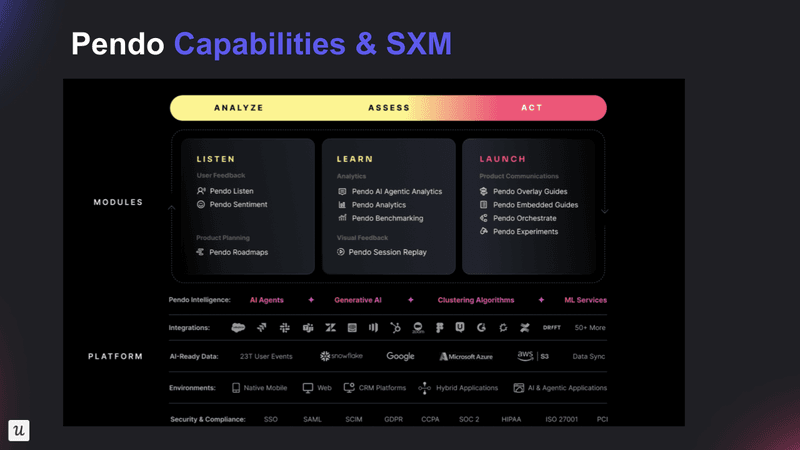
Product managers can typically use Pendo to:
- Understand user behavior: Funnels, paths, retention, and cohorts reveal where users convert or drop off.
- Drive in-app engagement: By deploying modals, banners, and tooltips with targeting and content localization options.
- Collect and triage feedback: Using NPS surveys, polls, and the Listen/Feedback modules to validate ideas and inform your product roadmap.
- Watch session replays: Analyze customer journeys and create funnels directly from replay timelines.
- Plan and communicate roadmaps: Share customer-facing roadmaps and align teams.
Pendo’s main features are:
- Analytics: Funnel analysis to measure step-by-step conversion, Paths to expose common navigation patterns, and PES (Product Engagement Score) that rolls adoption, stickiness, and growth into one metric.
- Guides & Resource Center: Walkthroughs and a center with modules for onboarding, announcements, knowledge-base integration, and feedback. Web guides support a wide set of video providers; mobile guides support YouTube URLs.
- Feedback & roadmapping: NPS and polls (guide-embedded), the Listen hub for AI-assisted theming, idea validation, and roadmaps tied to releases.
- Session replay: Team notes, tagging, and Jira handoff; funnels from replays.
- Integrations: Like Salesforce, HubSpot, Zendesk, and Segment.
The majority of Pendo’s customers include PMM teams seeking product usage signals and in-app experimentation, customer success and support closing feedback loops and monitoring health, and IT/digital adoption groups managing change and internal software rollout.
For pricing, Pendo publishes a Free tier (up to 500 monthly active users) and four paid bundles (Base, Core, Pulse, and Ultimate) with pricing that scales by monthly active users (MAUs). However, you need to contact their support team to request pricing details.
Independent benchmarks like Vendr show that the median Pendo customer spends $48,400 annually.
Limitations of Pendo
Don’t get me wrong, Pendos’ analytics are robust. They capture everything: user behavior, feature usage, funnel analysis. However, all that data can be overwhelming. These are the most notable I discovered from analyzing user reviews:
- No first-class hotspots; checklists are not standalone: Pendo’s hotspots are not native, and checklists live inside the resource center, not as a separate pattern.
- Resource Center gaps: Most end users note limited video support, no general search, and only one resource center per plan unless on Ultimate.
- Localization and some AI capabilities are add-ons: Localization and several advanced AI features(such as the writing assistant and guide creation) are only available for purchase as an add-on, except on the highest plan.
- Data freshness and dashboard setup: UI data refreshes hourly, with more manual dashboard building.
- Integrations are tightly gated: Plans include only one built-in integration; additional connectors typically require paid add-ons, requiring more effort to work with your current tech stack.
- Learning curve and fragmented navigation: Expect a steep setup and a heavier configuration burden for new teams.
- Session Replay cost/availability: Session Replay is included only in higher bundles, as an add-on for Base.
- Feedback module gating: Rich feedback analytics typically require Pulse/Ultimate or add-ons; otherwise, exports and joins are manual.
If you can’t work with these limitations, you can check out the best Pendo alternatives.
According to this G2 user:
“Pendo is pricey and the add-ons only make it more expensive.”
Userlane Overview
Userlane is a no-code digital adoption platform (DAP) that helps organizations discover which apps people use and understand how they use them through its HEART analytics framework. It helps to improve adoption with in-app guidance.
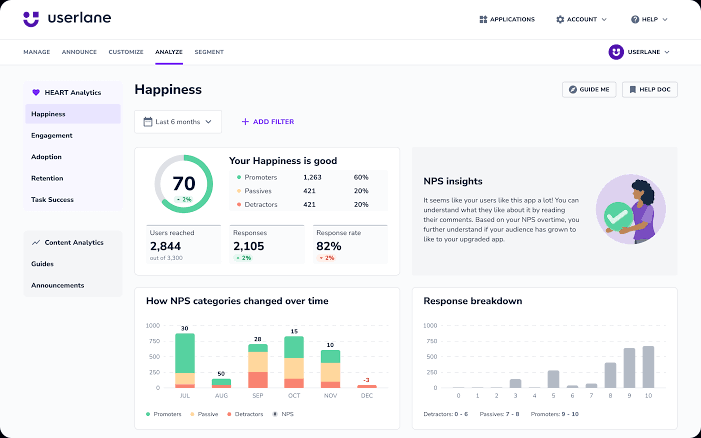
Userlane’s main use cases include:
- Employee onboarding and change management: Guide staff through CRMs/ERPs and accelerate digital transformation initiatives.
- License and app portfolio visibility: Uncover shadow IT and track which software applications employees use with App Discovery.
- Self-serve help inside apps: Deliver contextual walkthroughs, announcements, and surveys to reduce training and support requests.
Some of its main features are:
- Interactive walkthroughs & tooltips: Create in-app guides directly in your app, validate inputs, and segment by user or page for targeted in-app guidance.
- In-app surveys & NPS: Launch surveys and NPS in the Assistant and analyze responses in the Survey/NPS analytics views.
- HEART analytics & portfolio reporting: Track happiness, engagement, adoption, retention, and task success across applications.
- Knowledge base integration: Out-of-the-box connectors for SharePoint, Confluence, KnowledgeOwl, and Zendesk to provide help where work happens.
Most Userlane customers include IT and digital adoption teams, operations/L&D, and product managers rolling out internal web software at scale, often in enterprises needing governance and security controls.
Like Pendo, Userlane offers custom pricing.
From a G2 review:
“While the basics of Userlane are very intuitive, some of the finer details take a little longer to learn and implement.”
Limitations of Userlane
Userlane is effective for guided training, but product teams often encounter constraints related to styling depth, detailed analytics, branching logic, integrations, and total cost/effort.
- Styling depth is basic out of the box: However, deeper branding often requires custom CSS.
- Analytics focus on HEART analysis and don’t capture typed inputs: So granular user behavior analysis typically requires external tools.
- Branching logic and advanced guide paths are limited.
- Editing/reporting can feel clunky or error-prone: Due to friction between the portal and editor, tooltip issues, and unexpected errors.
- Knowledge base integrations exist but are limited: Customers request more providers (e.g., Zoho). In self-hosting, knowledge base search/integration is unavailable.
A better alternative: Userpilot
If you want speed without the setup drag, Userpilot is the better alternative.
Want to create a tooltip explaining a new feature? Userpilot lets you do it in minutes, right in your app, with no technical knowledge. And, unlike other solutions, our software helps you to go beyond just building product tours. You can create tooltips, hotspots, slideouts, and modals, using our UI templates, then ship them safely using our production and staging environments.
Want to know what your users really think? Use Userpilot to launch in-app surveys like NPS, CSAT, or quick polls to collect and respond to genuine customer feedback. And unlike Pendo, our software automatically links survey responses to actual user actions in the dashboard.
Our segmentation feature is straightforward (group user/company properties, events), so you can target messages or interactive walkthroughs based on real user behavior.
On user analytics, you don’t need to pre-tag everything. Our autocapture feature records clicks, text inputs, and form submissions from day one, allowing you to analyze product usage, spot friction quickly, and label only what matters.
If you need deeper context, use our session replay to understand a user’s workflow, watch their journey, and share clips with your team.
The results are evident. Shelterluv switched from Pendo to Userpilot and reduced support workload while improving engagement. From Matthew Brown, Senior Customer Solutions Manager:
“Switching from Pendo to Userpilot made our customer communication more effective and reduced our support workload significantly.”
At a glance, our key features include:
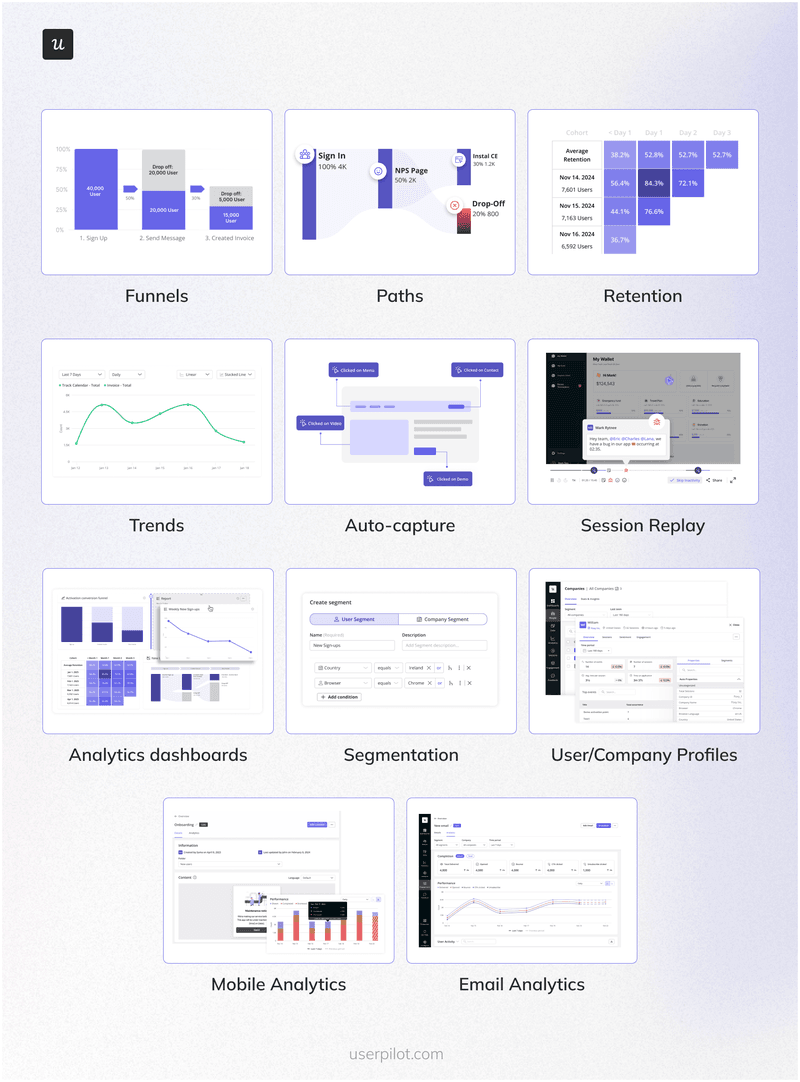
The best part?
Our pricing is transparent. Plans include:
- Starter plan from $299/month.
- Growth plan is customized and intended for growing teams.
- An Enterprise plan that is tailored to your product growth needs.
No surprise costs, just add-ons when you need them (e.g., unlimited session replays, mobile engagement).
Pendo vs Userlane vs Userpilot: User feedback
Getting user feedback right increases engagement and customer base. In the table below, I break down Pendo, Userlane, and Userpilot so you can turn signals into action with the least friction.
| Feature | Pendo | Userlane | Userpilot |
|---|---|---|---|
| NPS | ❌ Included only in Pulse and Ultimate plans or as an add-on; Free plan has NPS but is Pendo-branded. ✅ Email delivery and AI insights. |
✅ NPS available via the in-app assistant with basic reporting. ❌ No email delivery or AI insights. |
✅ Unlimited NPS included in Starter. ❌ Email coming soon; no AI. |
| Polls and surveys | ❌ Embedded inside Guides; creation is less intuitive. ❌ Only two templates. |
✅ In-app surveys delivered via the assistant. ❌ Fewer templates and lighter customization. |
✅ Dedicated survey modal or page for all feedback. ✅ 30+ pre-built templates and easy customization. |
| Sentiment, validation, and product roadmap | ✅ Automated theme detection and trend alerts. ✅ Idea validation. ✅ Product roadmap. = Available via Listen (Pulse/Ultimate; paid add-on for Base/Core). |
❌ NPS promoter/passive grouping only. ❌ No idea validation. ❌ No product roadmap. |
❌ Promoter/passive grouping only. ❌ No idea validation. ❌ No product roadmap. |
| Analytics and reports | ❌ Advanced analytics and AI Listen hub only in Pulse/Ultimate. ❌ Linking survey answers to user actions requires Listen; otherwise, manual export and join. |
❌ HEART-style dashboards; limited granularity. ❌ No automatic linkage of survey responses to in-app events without external tools/exports. |
✅ Built-in analysis without extra add-ons or integrations. ✅ Survey responses automatically linked to clicks, hovers, and form submissions in the dashboard. |
Pendo vs Userlane vs Userpilot: Analytics
With a reliable product analytics platform, you spot friction early, prove impact, and prioritize with confidence. I highly recommend working with a tool that fits your team’s reality so reports turn into releases, not meetings.
| Feature | Pendo | Userlane | Userpilot |
|---|---|---|---|
| Trends, funnels, paths, retention | ✅ | ❌ Focuses on HEART analytics rather than product-level funnels/paths. | ✅ |
| Event tracking | ✅ Collects auto events and supports Track Events; analysis usually requires tagging Pages/Features. | ❌ Tracks adoption via HEART and Content Analytics. Not a general-purpose, raw autocapture system for every UI event. | ✅ Autocapture logs clicks, hovers, and form submissions instantly; you can label events without manual tagging. |
| Segmentation & filtering | ❌ You must pass visitor/account metadata in the snippet or via sync; then segment with Data Explorer/Segments. | ✅ User segments for targeting and filtering analytics; supports standard and custom attributes. | ✅ Use user/company properties and event filters across dashboards and reports. |
| Heatmaps / clickmaps | ✅ | ❌ | ❌ |
| AI-powered insights | ✅ Insights and Listen provide AI summaries, themes, and retention drivers. | ❌ | ❌ |
| Product Engagement Score | ✅ PES: composite metric for adoption, stickiness, and new user growth. | ❌ | ❌ |
| Data latency | ❌ UI updates hourly (bulk calcs start at the hour; typically visible ~+15 min). | ❌ Dashboards update after events are processed. | ✅ Real-time: autocaptured clicks, hovers, and form submissions appear immediately in analytics. |
| Dashboards | ❌ One starter dashboard; build additional dashboards manually from widgets or Data Explorer templates. | ✅ Multi-app dashboard and HEART/Content Analytics views. | ✅ Multiple system dashboards + templates; create custom dashboards quickly. |
| Complexity | ❌ Higher setup/learning curve: requires passing visitor/account metadata and tagging Pages/Features; advanced modules add configuration. | ✅ Simpler for guidance analytics; deeper product analytics often require other tools. | ✅ Straightforward: no-code event labeling + autocapture reduces setup; minimal training for teams. |
Pendo vs Userlane vs Userpilot: Session Replay
Session replay turns vague issues into concrete moments you can watch, diagnose, and fix. Choose a tool that helps you move from understanding what happened to shipping the solution with minimal setup and smooth collaboration.
| Feature | Pendo | Userlane | Userpilot |
|---|---|---|---|
| Accessibility | ✅ Access session replay from multiple places in the product, and jump to replays from guides and heatmaps. | ❌ No native session replay. | ✅ Open from the Sessions tab; filter by users, companies, segments, or key events; save Playlists for fast review. |
| Team collaboration | ✅ Notes, comments, tagging; create Jira issues straight from a replay. | ❌ | ✅ Notes and quick reactions (bug/👍/👎) on the replay timeline; no native Jira integration. |
| Dashboards/pricing | ❌ Session Replay is a premium capability included on higher tiers (e.g., Core/Pulse/Ultimate) and custom quoted via sales; add-on for Base. | ❌ | ✅ 5,000 replays/month included on all plans; purchase additional capacity as an add-on on Growth/Enterprise. MAU-based pricing. |
| Complexity | ❌ Admin setup and configuration required; learning curve grows with cross-module workflows. | ❌ | ✅ No-code, auto-capture with built-in filters, playlists, skip-inactivity, and privacy controls. Minimal configuration. |
Pendo vs Userlane vs Userpilot: In-app engagement
An ideal user engagement software helps you deliver the right nudge at the right moment to turn friction into value realization that drives activation, adoption, and retention
| Feature | Pendo | Userlane | Userpilot |
|---|---|---|---|
| Localization & translation | ❌ Add-on / top-tier for full localization. | ✅ Auto-translate guides/assistant. | ✅ One-click auto-translate (incl. RTL) and CSV/XLIFF options. |
| Experimentation (A/B, multivariate) | ✅ Guide experiments available ❌ But only available on higher tiers and as an add-on. |
❌ No dedicated A/B testing for product tours. | ✅ Controlled A/B, head-to-head, and multivariate from Growth. |
| AI for authoring | ✅ AI guide creation and AI writing assistant. ❌ Available as an add-on and as part of the highest plan. |
❌ | ❌ Basic AI writing assistant only. |
| Guide analytics & goals | ✅ Guide metrics and goals. ❌ Requires Guides Pro. |
✅ Guide/assistant analytics with HEART-style views. | ✅ Built-in engagement analytics; goals tied to flows/checklists. |
| Complexity (setup & ops) | ❌ Steeper learning curve; metadata + page/feature tagging. | ❌ Can feel clunky to implement at scale. | ✅ Entirely no-code builder; unified UI; quick to launch. |
| Guide types / UI patterns | ✅ Modals, banners, tooltips, multi-step walkthroughs. ❌ No native hotspots. ❌ Standalone checklists. |
✅ Guides, tooltips, announcements/pop-ups, NPS. | ✅ Modals, slideouts, tooltips, walkthroughs, and customizable user onboarding checklists. |
| Resource Center / Assistant | ❌ Limited video support. ❌ No general RC search. |
✅ Assistant surfaces on-demand help and searches connected knowledge bases.. | ✅ Resource center with cross-module search + external knowledge base search. ✅ Linked videos play in-app. ✅ Unlimited resource centers from Growth. |
| Targeting, branching & logic | ✅ Segments + Guide Logic in Guides Pro/Ultimate. | ❌ Limited advanced branching/“choose-your-own-path.” | ✅ Flow Logic with if-then branching and granular page/segment targeting. |
| Customization & templates | ❌ Basic templates; deep CSS/JS theming requires Guides Pro. | ❌ Visual customization depth is limited for strict brand systems. | ✅ Rich UI template library + full styling controls. |
Pendo vs Userlane vs Userpilot: Mobile Engagement
Engaging users on their mobile devices makes it easier to motivate them to interact with your product daily. I recommend choosing a tool that fits your mobile stack and shipping needs, allowing you to implement changes faster.
| FEATURE | PENDO | USERLANE | USERPILOT |
|---|---|---|---|
| SDK platforms | ✅ iOS, Android, Xamarin, MAUI, React Native, Expo, Flutter, and Swift UI. | ❌ No native mobile SDK (web/desktop overlay via JS snippet or browser extension; mobile web only if your app is responsive). | ✅ iOS, Android, React Native, Flutter, Ionic, Capacitor. |
| In-app guides (mobile) | ✅ Carousels, tooltips, banners/lightboxes. ✅ Help Center (Resource Center) available in mobile apps. |
❌ No native mobile guides (guidance runs inside browser-based software only). | ✅ Carousels and slideouts. ❌ Tooltips. ❌ Resource Center. |
| Push notifications | ❌ No native mobile push. | ❌ Not supported (no native mobile). | ✅ Mobile push notifications supported (setup docs for iOS/Android). |
| Surveys & NPS (mobile) | ✅ Mobile NPS and surveys. | ❌ No native mobile surveys/NPS (available for web overlay, not native apps). | ✅ In-app surveys and NPS for mobile. |
| Analytics | ✅ Mobile analytics with low-code/retroactive capture; can run web & mobile in one subscription and compare across apps. | ❌ No mobile analytics (platform is web/desktop overlay). | ✅ Mobile analytics dashboards (e.g., Most Visited Screens) and cross-platform filters (web vs mobile). |
| Pricing | ❌ Custom quote. | ❌ Custom quote. | ✅ Mobile Engagement available as an add-on for Growth & Enterprise. |
Pendo vs Userlane vs Userpilot: Integrations
The best tools integrate with your CRM, support, and analytics seamlessly to prevent data silos that can hinder business growth.
| Integration | Pendo | Userlane | Userpilot |
|---|---|---|---|
| Salesforce | ✅ 2-way (usage + feedback ↔ CRM). | ❌ (No native CRM connector; guidance runs over Salesforce UI). | ✅ 2-way (contacts/companies + events). |
| HubSpot | ✅ 2-way (pull properties, push usage/NPS). | ❌ (Not listed among supported integrations). | ✅ 2-way (lists, properties, campaigns). |
| Intercom | ✅ 1-way (embed chat in Resource Center; paid add-on). | ❌ (Not a supported connector). | ✅ 1-way (send events to Intercom; KB embed). |
| Zendesk | ✅ 2-way (embed chat/help center + push usage, sync feedback). | ✅ KB integration (Assistant searches Zendesk articles; no product-data sync). | ✅ 1-way (knowledge base + ticket links). |
| Jira | ✅ 1-way (create/link issues from Replay/Listen). | ❌ | ❌ |
| Segment (CDP) | ✅ 2-way (receive Segment data; send Pendo events via webhooks). | ❌ | ✅ 2-way (send to Segment; also receive via APIs). |
| Webhooks | ✅ Event webhooks, including Segment target. | ❌ | ✅ Real-time outbound webhooks. |
| Google Analytics | ✅ 1-way / via GTM & exports. | ❌ | ✅ 1-way (send Userpilot events to GA) |
| Amplitude / Heap / Mixpanel | ❌ No direct connectors (route via CDP/warehouse). | ❌ | ✅ 1-way (send events to Amplitude/Heap/Mixpanel). |
| Okta (SSO) | ✅ | ✅ | ✅ |
| Slack | ✅ | ❌ Link-only from the Assistant (you can add a Help link to Slack/MS Teams; no data sync). | ✅ |
| Zapier | ✅ | ❌ | ✅ |
| Woopra | ❌ | ❌ | ❌ |
Pendo vs Userlane vs Userpilot: Best fit scenarios
Here, I’ve outlined each platform with its best use cases so you can confidently make the right choice that fits yours.
| When to Choose Pendo | When to Choose Userlane | When Userpilot Is the Better Choice |
|---|---|---|
| • Large enterprises with dedicated product ops teams. • Companies needing extensive customization and enterprise features. • Organizations with complex user hierarchies and permissions. |
• Companies focused primarily on employee onboarding. • Teams that need highly visual, step-by-step process guides. • European companies prefer local data hosting. |
• Product-led growth companies seeking rapid implementation. • Growing companies and enterprises. • Teams that want simplicity without sacrificing functionality. • Companies prioritizing speed and reliability over feature bloat. • Organizations needing seamless migration from existing tools. • Teams with limited technical resources requiring no-code solutions. |
Choose the platform that accelerates product adoption
We’ve compared Pendo vs Userlane across several key areas, including user engagement, product analytics, and pricing plans.
Here’s our verdict: Pendo works for enterprises that need breadth and governance, Userlane fits employee onboarding with step-by-step guides. And our better alternative, Userpilot, is the faster path for creating in-app guidance elements without developers, accessing actionable analytics, and collecting survey responses tied to real behavior.
Book a demo to see how Userpilot helps you get faster time to value, retain customers, and spend time on getting results, not configuration.

